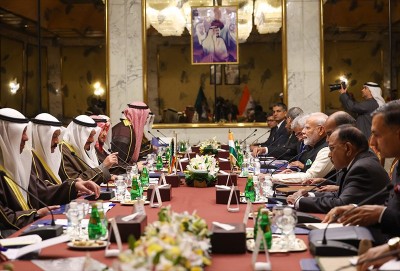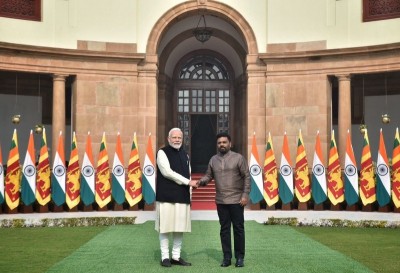
Bahudha approach can lead us our quest for peace and harmony: Vice President
New Delhi, Oct 30 (IBNS): Vice President of India M. Venkaiah Naidu has said that the Bahudha approach is yet another shining star that can lead us our quest for peace and harmony.
He was addressing the gathering after releasing the Book ‘The 21st Century Geopolitics, Democracy and Peace’ authored by former Governor of Sikki, Shri B.P. Singh, here on Monday.
The Governor of Jammu and Kashmir, N.N. Vohra and other dignitaries were present on the occasion.
The Vice President complimented Shri Singh for penning this book, which is highly relevant in the context of increasing globalization, growing terrorism and unprecedented technological advances.
He further said that it indeed deals with a wide range of issues that are increasingly affecting an inter-dependent globalised world and strongly advocates that it would be ideal if we can adopt a ‘Bahudha’ approach which emphasizes the need for a dialogue to promote a harmonious and peaceful living.
The Vice President said that issues touched upon in the book include the role of educational institutions, progressive religious and social groups, forums for inter-faith dialogue and international institutions like the United Nations.
It makes a strong case for promoting moral values, empathy and compassion and channelizing energies towards peace and development, he added.
The Vice President said that other interesting chapters are ‘Democracy and its Consequences’ and ‘Good Governance: A Narrative from Democratic India’. He further said that in the chapter, ‘The Emerging World: Challenges and Possibilities’, Singh quite correctly says that the future of peace and harmony in the 21stcentury would be directly linked to (i) ecology, global warming and climate change; (ii) nuclear weapons, emerging technology of warfare and continuing arms race among nation-states; (iii) geopolitics and nationalism; (iv) religious extremism and (v) poverty and inequality.
Following is the text of Vice President’s address:
“I am extremely delighted to release the book, “The 21st Century: Geopolitics, Democracy and Peace” written by former Sikkim Governor, Mr. B.P. Singh. Writing books is not new to Mr. Singh, a former IAS officer, who served with distinction in several positions in Assam and the Government of India.
I compliment him for penning this book, which is highly relevant in the context of increasing globalization, growing terrorism and unprecedented technological advances that are rapidly changing the way we live.
Frankly speaking, this book generates a lot of optimism and dispels cynicism about the future of the world and focuses on the innate goodness in all human beings. It has great relevance to our times.
We live today in turbulent world, a world that is being fragmented by narrow walls of prejudice on every conceivable issue. This book presents a viewpoint that is radically and refreshingly different.
It indeed deals with a wide range of issues that are increasingly affecting an inter-dependent globalised world and strongly advocates that it would be ideal if we can adopt a‘Bahudha’ approach which emphasizes the need for a dialogue to promote a harmonious and peaceful living.
It needs no reiteration that peace is an essential pre-requisite for progress of mankind, especially when the world is witnessing an increasing number of conflicts. In the context of the rise of terrorism and religious fundamentalism, which are threatening world peace like never before, the Bahudha approach advocated by the author is a good way to resolve even the most intractable problems.
The issues touched upon in the book include the role of educational institutions, progressive religious and social groups, forums for inter-faith dialogue and international institutions like the United Nations. It makes a strong case for promoting moral values, empathy and compassion and channelizing energies towards peace and development.
The author while outlining the rationale behind the book refers to the complexity of the evolving world in the 21st century.
He has touched upon key trends likeunprecedented scientific and technological development, previously unheard of prosperity and mind-boggling advances in the means of communication.
He recognizes major challenges confronting us like conflicts, natural calamities, hunger, malnourishment, pandemics, denial of education, violation of human rights and much else.
However, he is not pessimistic. He believes that despair would be a kind of self-indulgence. “One can see that there are very many positive signs on the geo-political map of the world”, he concludes and observes that the respect for another person’s point of view—the cornerstone of the Bahudha approach is on the rise.
While discussing how terrorism and fundamentalism are threatening world peace, the author says the new challenge calls for bold and imaginative statecraft from world leaders. He proposes the concept of Bahudha while calling for transcending age-old peace mechanisms and reconstructing our language of discourse.
Nobody can be in disagreement with his viewpoint that Bahudha approach is necessary at individual, group, national and global levels. It provides a moral choice between ‘the clash of civilizations’ and ‘harmony among civilizations’, as he puts it.
In the Chapter on ‘Interplay of Ideas: The Indian Story’, Mr. Singh rightly points out that India is much more than a large market place. Its history is not only a story of kings and queens and mere chronicle of invasions and conquests. Both in times of decline and distinction, India is a land alive with vital ideas and thoughts.
In the chapter dealing with ecological issues in the Himalayan region, the author points out that climate change has to be viewed in the context of enormous disturbance to eco-systems. He says the threat to South Asia is especially more tangible both in the Himalayan region and in the Western Ghats. One cannot continue living as in the past. If the Himalayan glaciers melt and the forests will be lost at an alarming rate with many birds, mammals and other species on way to extinction, we would be making our planet more uninhabitable and unsustainable.
As I have been long advocating, Mr. Singh too emphasizes the need for imparting ethical values to students and sensitizing them to the needs of a harmonious society in the chapter on ‘Science, Spirituality and Ways of Living: A plea for Integrated Education’.
Other interesting chapters are ‘Democracy and its Consequences’ and ‘Good Governance: A Narrative from Democratic India’. In the chapter, ‘The Emerging World: Challenges and Possibilities’, Mr. Singh quite correctly says that the future of peace and harmony in the 21st century would be directly linked to (i) ecology, global warming and climate change; (ii) nuclear weapons, emerging technology of warfare and continuing arms race among nation-states; (iii) geopolitics and nationalism; (iv) religious extremism and (v) poverty and inequality.
Emphasizing that the role of national and global multilateral organizations would be vital, Mr., Singh observes that the 21st century would be dominated by a pluralist ethos; multiple nation-states, multiple centres of power; multiple faiths; multiple cultures; multiple economies and multiple languages.
He says, “We cannot envisage a world without conflicts or natural disasters. All I am advocating is to bring down mind walls that divide people and create hatred”.
Indeed, that has to be effort at every level—at individual, community, nation-state and global-- for peace and prosperity to co-exist and to make this planet a truly marvelous place for humans and all other living creatures.
Bringing down walls that divide us, engaging in dialogue, appreciating each other’s viewpoints and promoting peaceful co-existence has been the essence of Indian ethos from time immemorial.
It is this world view that we need to draw upon. The Bahudha approach is yet another shining star that can lead us our quest for peace and harmony.
As mentioned earlier, it is a timely book. It is a book that offers hope. It is a book that should trigger a thought process towards a better world.
I once again compliment the author, Mr. Singh and hope that his writings will inspire more Indians to look back at the rich heritage, draw inspiration and move forward.
Jai Hind!
Support Our Journalism
We cannot do without you.. your contribution supports unbiased journalism
IBNS is not driven by any ism- not wokeism, not racism, not skewed secularism, not hyper right-wing or left liberal ideals, nor by any hardline religious beliefs or hyper nationalism. We want to serve you good old objective news, as they are. We do not judge or preach. We let people decide for themselves. We only try to present factual and well-sourced news.







